Whether you see them in the wild or in zoos, peacocks are one of the most majestic-looking birds that always attract people’s attention. Their beautiful ornamental tails contribute to their striking appearance, leading people to think that raising these birds must be pretty hard.
But that’s not entirely true. In fact, peacocks can easily be raised as pets or even for profit.
There are many reasons why raising peacocks is beneficial. For one, they have a longer lifespan than other large birds. Peacocks generally live between 12 and 15 years and some can even live up to 50 years.
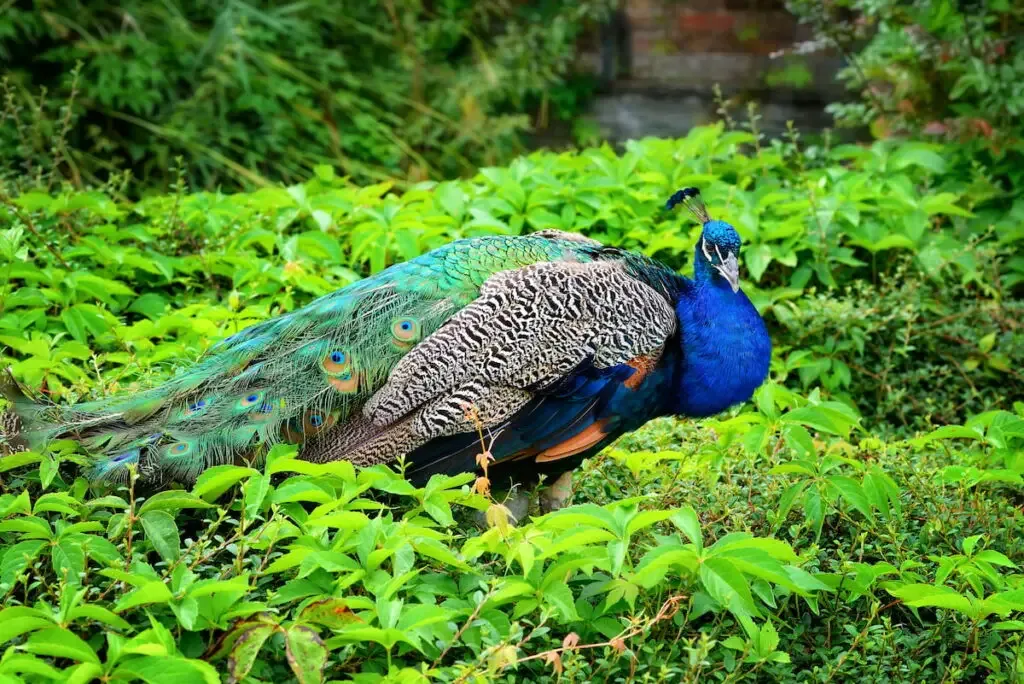
Aside from their aesthetic value, peacocks yield delicious meat and eggs. Their eggs are three times as large as chicken eggs.
So, if you’re thinking of raising these birds, this guide will explain what you need to be a successful peacock owner from start to finish.
What Breeds Of Peacock Should You Choose?
Peacocks are native to Asia and Africa. They belong to the family Phasianidae and were kept as pets by Europeans and the Chinese historically. Peacocks are generally polygamous, mating with two or three peahens.
Through mutations and selective breeding, peacocks come in different variations including black, yellow, purple, and even albino. But all these variations originate from standard green or Indian peacocks.
Although the United Peafowl Association recognizes 225 peacock or peafowl varieties, there are only a few major breeds that can be found all around the world including in the United States.
With that said, these are the three most commonly raised peacocks:
1. Indian Peacock (Pavo cristatus)
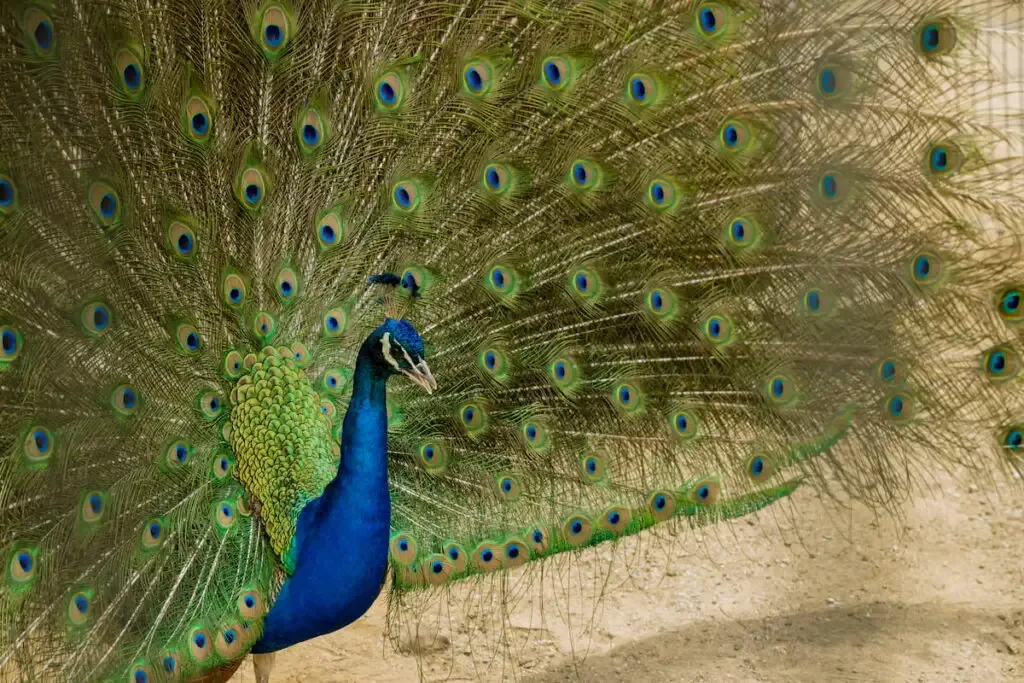
Indian peacocks are also known as blue peacocks and common peacocks. They are native to India, Sri Lanka, and other regions in Eastern Asia. These birds can be recognized by their distinctive iridescent blue-green plumage.
Their upper tails are elongated with eye-like markings at the end of each feather. Males measure between 25 and 28 inches in length while females measure between 24 and 25 inches in length.
Peahens are generally duller in color with a mix of dull green, greenish-grey, and iridescent blue. One way to recognize the females from the males during the normal season is through the green color of their neck.
There are many variations of the Blue Indian peacocks including white, black-shouldered, oaten, purple, midnight, pied, and opal.
Females typically lay between 4 and 5 buff white eggs that take around 28 days to be incubated.
2. Green Peacock (Pavo muticus)
Green peacocks are also known as the Java peacocks. They originated in the tropical forest of Southeast Asia, inhabiting open forests and watery regions.
Males and females are similar in appearance. They have iridescent green necks, dark wings, and vertically-held dark green crests. Both sexes have long upper tail coverts and in males, these coverts can extend up to 78.7 inches (6.6 feet).
In the wild, green peacocks spend most of their time on the ground near tall grasses and sedges. During the day, they can be found in groups foraging, drinking, preening, and mingling with other birds in the same group. At night, they roost in trees at a height between 33 to 49 feet.
Unlike other peacocks, green peacocks are generally silent except during the dawn and dusk when males call from their roosting sites with a loud call of ‘ki-wao.’ Females will make loud ‘aow-aa’ calls repeatedly for a short period of time.
They lay between 2 and 6 eggs that take around 26 to 28 days to be incubated.
3. Congo Peacock (Afropavo congensis)
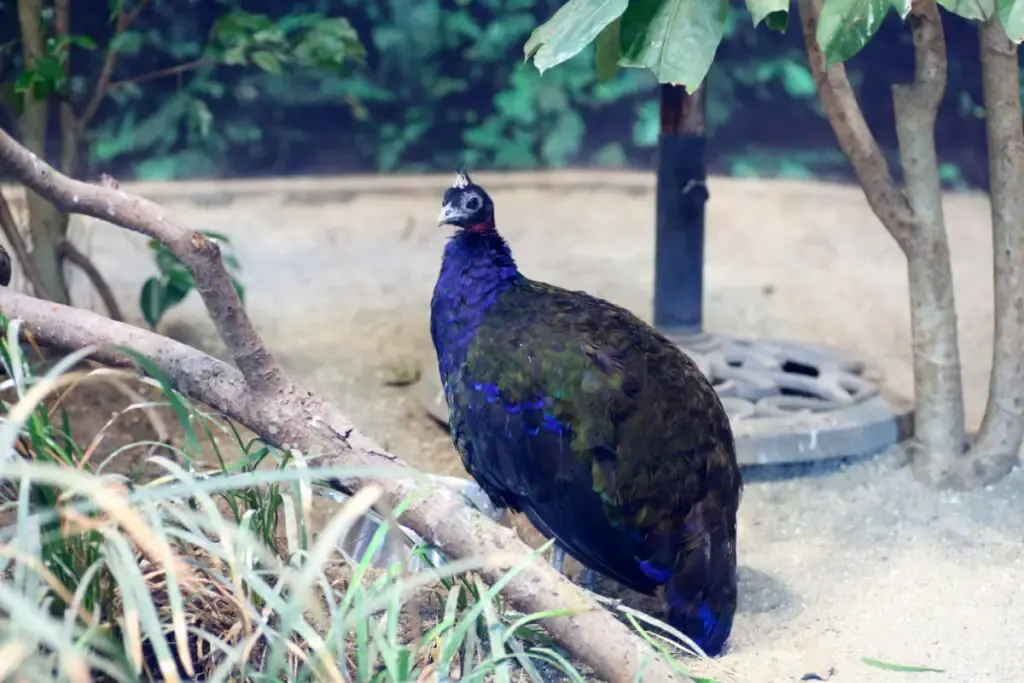
This peacock breed is the national bird of the Democratic Republic of the Congo. Congo peacocks are endemic to the Central Congolian lowland forests but have been preserved both in primary and secondary forests in Salonga Park.
Males can be recognized by metallic green and purple patches on their dark blue bodies, while females possess chestnut breasts with iridescent bright green feathers and metallic backs. Peacocks of this breed generally measure between 25 and 28 inches in length and the peahens measure between 24 and 25 inches.
These birds can live up to 20 years. Females can lay between 2 and 4 brown eggs that take around 28 days to be incubated.
No matter which breed you choose, be sure to purchase a healthy bird. If possible, do quick research on the hatcheries or breeders that you are interested in before buying. Contact them and ask for a medical history of the bird.
Observe the peacock carefully and look for any signs that indicate that the bird isn’t healthy. Avoid buying peacocks during their molt season because it can be hard to tell if they’re genuinely healthy during this period.
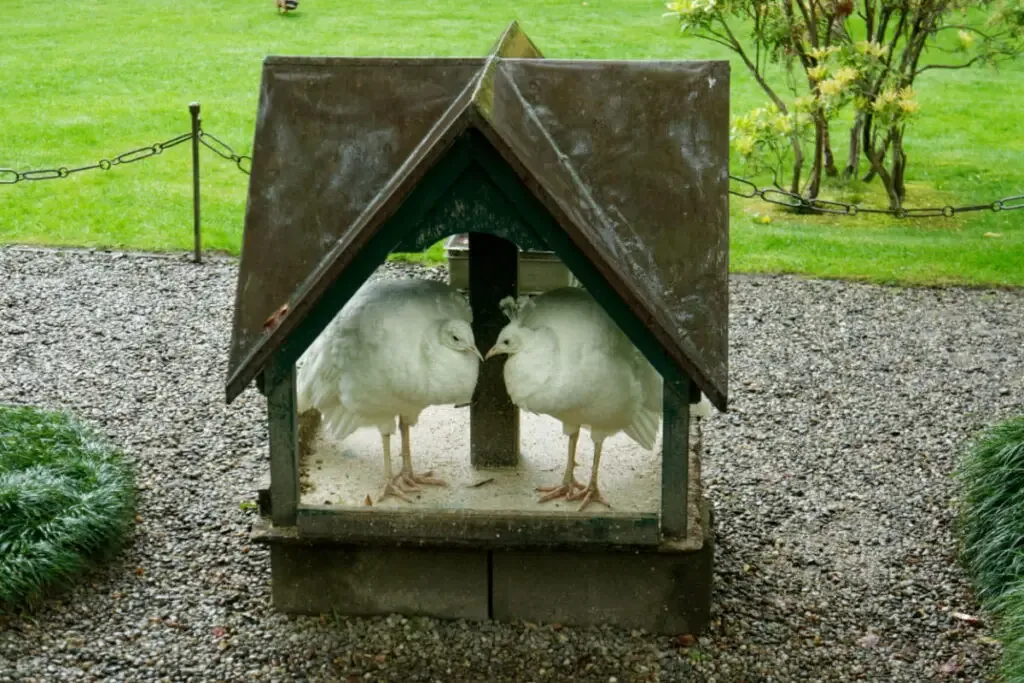
Building Your Peacock Shelter
Although keeping peacocks free-range on your land or property is considered the best way to keep these birds happy, they also need shelter to protect them from all the elements. Their housing is a place to stay dry during rainy seasons, windy days, and most importantly, a structure that keeps them warm in cold seasons.
There are a few key components to building a good peacock shelter. These include:
1. Space
Sheltering peacocks is different from sheltering other small domestic birds. Due to their large body size, peacocks generally need a lot of space compared to peahens.
If you’re keeping peacocks in pens or coops, the optimum size to have for each bird is around 80 to 100 square feet with a minimum height of 8 feet to allow room when they fan their feathers.
2. Housing Types
There are many types of shelter that you can build for peacocks such as barns, large tree houses, or even designated coops. If you are looking for something simple, a prefabricated shed or three-sided shelter made from plywood or strong boards can work.
You can also use 2-by-4 boards to make a roosting board. The board should be placed between 3 and 6 feet above the ground.
During cold seasons, the surrounding temperature might drop below freezing. So you need to insulate the walls and floors or use a panel heater to keep your peacocks warm. Panel heaters can be used to regulate temperature even to the lowest level to avoid temperature shock.
3. Bedding And Nesting Areas
Peacocks need bedding to rest and sleep at night. They don’t require extensive and fancy bedding so you can use materials like straw and pine shavings. Keep their bedding dry, cozy, and free from any moisture. The bedding will also insulate your peacocks’ bodies, especially in cold seasons.
To construct peacocks’ nesting areas, the procedure is similar to creating their shelter. First and foremost, they need the same amount of space between 80 to 100 square feet per bird. Then, find a 55-gallon plastic drum and cut it down to about a third of its height.
Make sure the drum doesn’t tip by nailing it onto the wooden floor of the shelter or putting some bricks at the bottom of it. After that, you can nail two 1-by-8 boards to create a 16-inch wall at the corner of the shelter. Fill the nesting areas with straw or wood shavings.
Remember to change them regularly to keep the areas clean and moisture-free.
4. Fencing
Safety should always be a cause for concern. This is true especially if you’re living in areas that are filled with predators of peacocks such as coyotes, wild dogs, and foxes. Both their shelter and nesting areas must be fenced properly.
You can use hardware cloth and chicken wire and attach them to sturdy wooden posts. Then, the posts can be set every 8 to 12 feet around the perimeter of their living area. You should also bury the bottom of the wire at least 6 inches deep to prevent digging predators from breaking in.
Last but not least, don’t forget to provide feeders and waterers for your peacocks. These bowls or plates should be placed near their housing but away from gaps under their housing to avoid droppings from falling into their feed.
It is also best for you to do a quick sweep around their shelter and nesting areas to look for objects that can hurt the birds such as broken glasses or rusty nails.
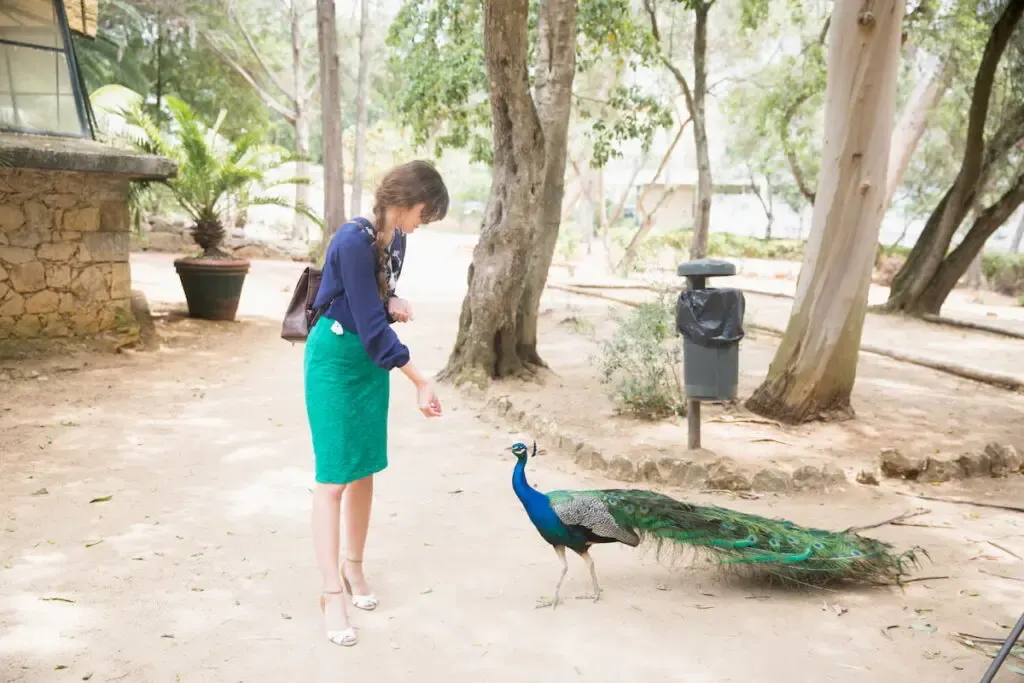
Feeding Habit And Dietary Requirements
Feeding peacocks is fairly easy. They are omnivorous and eat both fiber and protein-based diets. Being opportunistic feeders, their diet in the wild ranges from insects, small reptiles, arthropods, amphibians, to seeds, flowers, and other parts of plants.
When keeping peacocks domestically, you definitely can incorporate some of this food into their diet. But there’s nothing wrong with improving their nutrition by providing them with feed that they can’t get out in the wild.
For instance, you can feed them a grain-based diet from a commercial game bird feed or a chicken feed. Then supplement their diet with green vegetables such as broccoli, chopped carrots, cabbage, beets, and peas. You can also add mealworms, boiled eggs, or cat food into their feed as an additional source of protein.
Peacocks eat frequently throughout the day and they require a high amount of protein. So you will see that even after you’ve fed these birds, they will roam and forage for food.
If you keep your peacocks free-range on your property, you will have to worry less about giving them treats. They will happily forage and scour the ground for some insects, seeds, and reptiles just like in the wild.
Also, don’t forget to provide clean water each day. Although peacocks don’t drink as much as other large animals, they still need water to keep them hydrated and aid in better digestion when feeding.

Raising and Brooding The Peachicks
Peahens generally take care of peachicks until they can live independently without their parents. However, if you intend to start your own peacock farm from peachicks, there are certain aspects that you should know about raising these birds at a very young age.
Brooding
If you want to purchase peachicks from reputable breeders, they are only available in the summer and spring months due to the peachicks’ sensitivity to low temperatures and cold environments. Similarly, when you keep these young birds on your property, they must be placed inside a draft-free brooder for the first eight weeks.
The temperature inside the brooder should be set around 95 degrees Fahrenheit before being reduced by 5 degrees each week until they reach the age of two months old.
Housing
Peachicks don’t need a large space. A standard chicken or turkey coop can be used to house them. Once they have reached two months old, you can transfer to another spacious coop or shelter. Their housing serves to protect them from predators and harsh weather. So, be sure to find the something that is strong, stable, and will last for a long period of time.
If you build their housing from scratch, be sure to leave some small gaps on the floor. This is because peachicks poop a lot and you want to avoid their droppings from accumulating inside their housing.
Feeding
Peachicks need a high-protein feed that promotes healthy growth. You can feed them a game bird starter or turkey feed that can be bought in any poultry feed store. This diet should be maintained until they reach 3 months old.
Aside from protein, you can also supplement their feed with leafy vegetables such as spinach, dark lettuce, and cabbage. Avoid anything fatty or salty. Once they have matured, you can switch their feed to the normal pellets.
Also, be sure to supply them with enough fresh and clean water.
Worming
Peachicks are prone to worm problems. If possible, try not to mix or house peachicks with other domestic fowls such as chickens, turkeys, and ducks. This is because peachicks don’t have a similar tolerance to parasites like other poultry birds.
Don’t hesitate to consult a veterinarian or any poultry and game birds experts if you need to do some deworming.
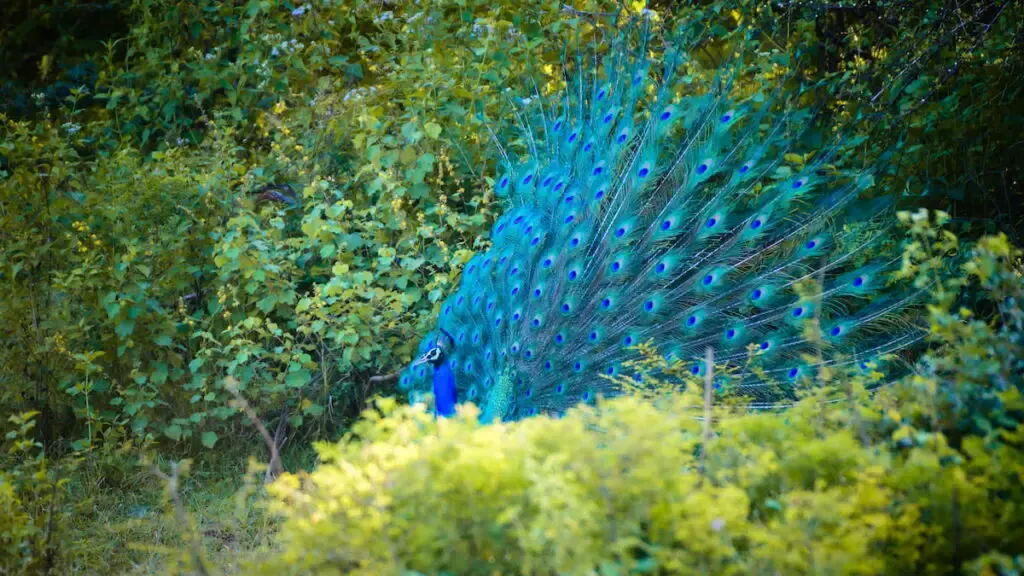
Breeding Your Peacocks
As polygamous birds, peacocks will generally mate with more than one peahen. Generally, their breeding season starts around March and ends in August.
Peahens don’t lay eggs in their first year but in their second and third year, they will lay between two and three eggs. During the fourth year, peahens will lay between five to nine eggs per year. In some cases, peahens can lay eggs even before they are being bred.
When mating, peacocks will dance to display their trains. This behavior serves to attract potential peahens that would mate with the dancing peacocks.
Peacocks will also become noisy during their mating season. So, don’t be alarmed when you notice they produce louder calling sounds compared to other months.
After the mating period and the males lose their tail trains, egg production and fertility levels will drop significantly. Peahens typically lay between 12 and 40 eggs on the ground or in their nesting areas. These eggs will be incubated for around 28 to 30 days.
If you intend to incubate the eggs without the mother, there are a few things that you should do in order to do it properly.
First, the eggs must be candled after 10 days of incubation. The eggs must be kept in an environment with a temperature between 99 to 100 degrees Fahrenheit. If possible, quickly place the eggs inside the incubator as soon as the peahens finish laying all their eggs.
Diseases And Health Management
Like many animals, peacocks’ health should be monitored to prevent any diseases that could cause serious problems or worse, death in these birds.
Some of the illnesses that you should watch for in peacocks are below.
Respiratory diseases
Peacocks are prone to respiratory diseases that can spread quickly if they’re not treated at an early stage. These include fowl pox, Newcastle diseases, avian pox, aspergillosis, and many more. Some diseases will show early symptoms that are visible for just a physical examination such as sinuses and swollen eyes.
Some of these issues can be treated by prescribing antibiotics but not all of them will completely go away. Some of the things that you can do to prevent this issue are regular cleaning of your peacocks’ shelter and living space, providing them with a healthy and balanced diet, and a yearly check-up by an avian veterinarian.
External Parasites
External parasites that attack peacocks are mostly mites and lice. These parasites are fatal to the birds if they are left untreated. Mites will live on the peacocks’ bodies and feed on their blood, sucking all the nutrients they need to grow and live.
This could cause anemia, weight loss, and compromised immunity in your peacocks. Aside from vet treatment, you can use poultry pesticides to combat this issue.
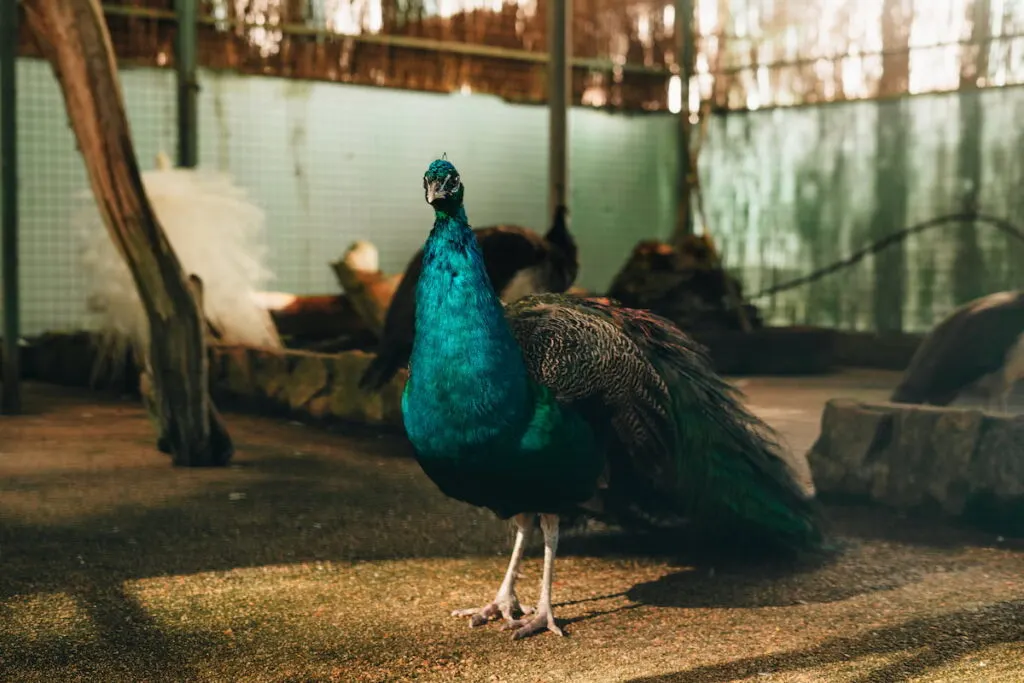
Worms
Worms don’t only happen in chickens, ducks, turkeys, and other domestic birds. They can also happen in peacocks.
One of the obvious reasons why peacocks are prone to suffer from worm issues is due to their foraging habit. These birds will pick up worms whenever they spend time outside their housing.
Free-range peacocks are more prone to worms compared to those that live inside shelters. So you should schedule regular deworming sessions to treat this issue from causing more serious problems in your peacocks.
Some of the early symptoms of worms are ruffled feathers, weight loss, and lameness.
Diseases in Peachicks and Young Peacocks
Young peacocks are prone to coccidiosis that can lead to sudden death if left untreated. This disease generally doesn’t happen in adult peacocks. Early signs of coccidiosis that you should look for are ruffled feathers, lameness, and bloody diarrhea.
Feeding peachicks and young peacocks with medicated feed is just one of the many ways to prevent this issue. Proper hygiene and keeping their living space free from any contamination should also be done in order to avoid this problem from recurring.
Final Thoughts
Above all, raising peacocks can be a rewarding and exciting experience. Although they are not as popular as other domestic poultry birds, having peacocks will definitely add color and fun to your backyard or farm.
In addition to being great pets and producing both meats and eggs, these birds help in reducing pests, snakes, and other harmful insects.
Either way, it’s a win-win situation for you and your birds!
Citations:
- https://meyerhatchery.zendesk.com/hc/en-us/articles/360010700951-Peafowl-Brooding-101-How-to-Raise-Peachicks-from-Arrival-to-Outside
- https://www.inpoultry.com/raising-peafowl
- https://morningchores.com/raising-peafowl/
- https://www.backyardchickens.com/articles/how-to-raise-peafowl-information-on-the-basics.67208/
- https://thriftyhomesteader.com/raising-peafowl/
- https://animals.mom.com/care-peacock-chicks-6395.html
- https://www.roysfarm.com/peacock-farming/
- https://www.vikingthelab.com/how-to-raise-peafowl/
- https://www.purinamills.com/chicken-feed/education/detail/beyond-backyard-chickens-raising-peacocks-and-game-birds
